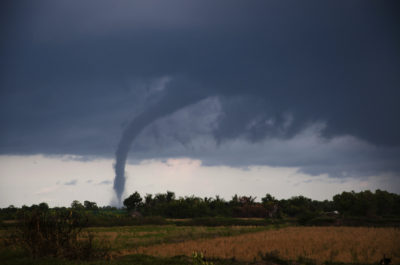Tornadoes are among the most common, and unpredictable, severe weather events. Unlike hurricanes or blizzards, which meteorologists can often forecast days in advance, tornadoes typically develop spontaneously from severe thunderstorms and can make landfall anywhere along a storm’s path. Sometimes dozens of twisters spawn out of one large storm system.
More than 1,000 tornadoes occur every year in the U.S., leading to about 80 fatalities—due mostly to flying or falling debris, according to AccuWeather.com. In fact, the U.S. has more tornadoes than any other country in the world.
Residents of tornado-prone areas like the Great Plains (“Tornado Alley”), the South and Southeast and the Midwest should have a plan in place in case a tornado strikes their community or, worse, their home. Even if you live in an area that only infrequently experiences tornadoes, it makes sense to know your risks and be prepared.
Here are some tips to help ensure that you and your loved ones are ready—and safe—in case a tornado strikes:
Create an Emergency Plan: Essentials To Include
Would you and your family know what to do if a twister struck your community? Prepare in advance by putting together a tornado emergency plan. Keep it in an easy-to-remember place and make sure that everyone in your household is familiar with it. The plan should include such considerations as:
Where to seek shelter
If you’re at home, your basement, an underground storm shelter or an enclosed, low-level bathroom or closet are typically the safest spots during a tornado, according to the Centers for Disease Control and Prevention (CDC). Avoid windows (which can shatter) and other objects that could become projectiles. “Flying debris causes most deaths and injuries during a tornado,” the CDC advises. You should also identify the closest tornado shelters in your community—don’t get caught in your car if you’re away from home. An automobile is among the most dangerous place to be during a tornado. Your local police or fire department can help you identify designated shelters in your area.
When to seek shelter
Be aware of the signs that a tornado may be developing in your area—and don’t count on your local emergency siren to signal it first. A green-colored sky, low-lying rotating clouds, large hail and a loud, train-like roar are signs a tornado may be near.
Who to contact
Make a list of key telephone numbers, including those of family members, close friends, the claims office for your homeowners and auto insurance company, and local emergency officials such as the police and fire department. Also put together a family communication plan that outlines how you and your family will reach each other should you become separated during the storm.
Identifying special risks in your household
Consider whether anyone in your household may need special assistance during a severe storm, as you may need to make emergency plans specific to that person. Make sure they know where to go during a storm and have the ability to get there on short notice. If they rely on electricity to operate medical equipment, for example, you may want to consider installing a backup generator in case a severe storm or tornado knocks out the power. Also, don’t forget about your pets and how you would protect them during a tornado.
Storing important records
Compile all of your key personal documents (including your driver’s license, Social Security card, medical records, financial records, insurance policies and home inventory) and place them in a safe, accessible spot, such as a file cabinet or secure fireproof box. You might also want to consider storing electronic versions of these records on the cloud (e.g., Google Drive) so that you can access them remotely in case your home is severely damaged.
Get more tips from The Hartford on how to discuss disaster planning with your loved ones.
Prepare a Disaster Kit
Put together a disaster kit in case you or someone in your household becomes injured or stranded due to a passing tornado. It should be easy to transport should you need to evacuate your home or community.
Contents to include:
- Nonperishable food and bottled water
- Extra supply of any prescription and over-the-counter medications household members may need
- Blankets and pillows
- Flashlights and extra batteries
- Portable radio
- Emergency phone numbers
- Pet food and any supplies you will need to take care of a pet
If someone in your household has a disability or special health issue, consider putting together a disaster kit specifically for that person, which could include a list of that person’s medications, the caregiver’s and the doctor’s contact information, any special instructions for caring for that person in case they are separated from their caregiver, and personal identification. Read these tips on disaster planning if someone in your household suffers from Alzheimer’s disease or dementia.
Stay Safe After the Storm
If a tornado does damage your home or community, take careful precautions to protect yourself and your loved ones from injury. As always, safety comes first. Do not leave your sheltered area until you have official confirmation that the storm has passed and no further damage or destruction will occur. (Check your hand- or battery-powered radio or TV for instructions from local public safety personnel.)
Be vigilant when walking through damaged areas. Wear sturdy shoes and long clothing and do not attempt to clean up the debris. Rather, focus on getting everyone out of the damaged area without harm. Broken glass, exposed nails, electrical wires, downed power lines, flooding, and collapsed structures are just a few of the potential hazards to avoid, according to the CDC.
Once you’ve all reached a safe place, contact emergency personnel to report the damage and receive instructions on where to go. When tornadoes cause major damage to an area, relief organizations such as the American Red Cross will often set up shelters with food and supplies that can help you reconnect with loved ones you may have lost track of during the storm.
The best time to prepare for a tornado isn’t five minutes before it strikes. Rather, families should be making severe weather disaster plans when they don’t need them—so that they’re ready if they ever do.







Very helpful, thank you.